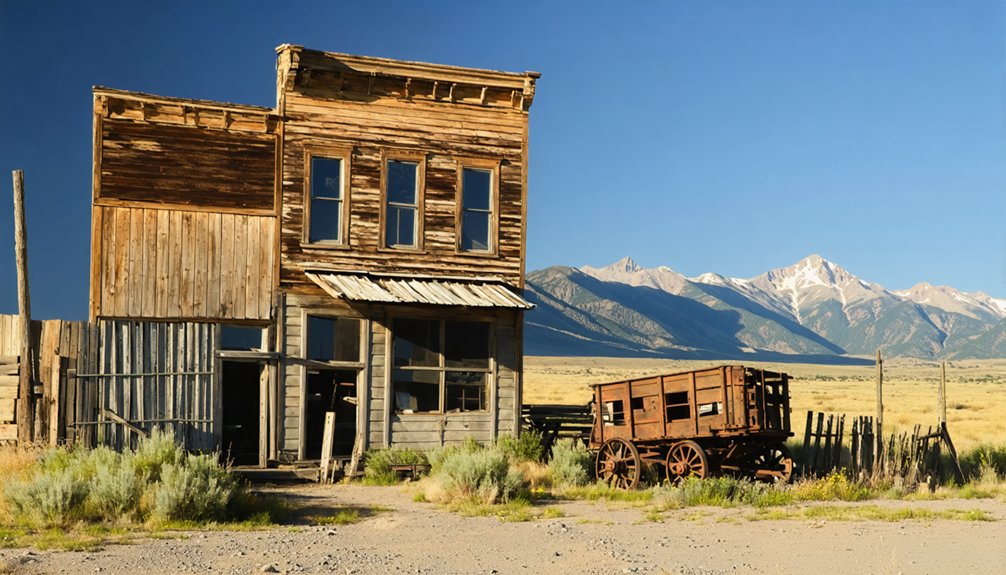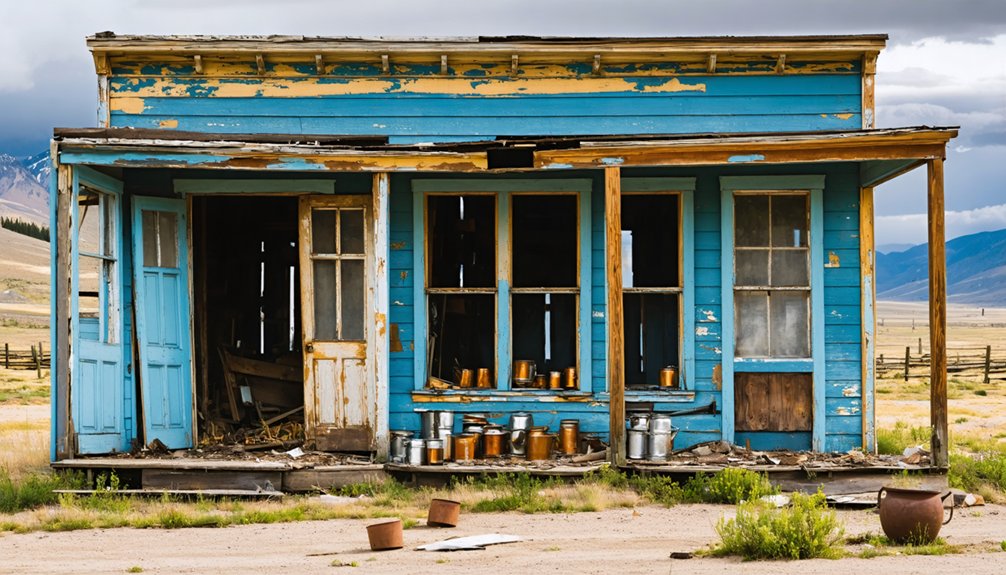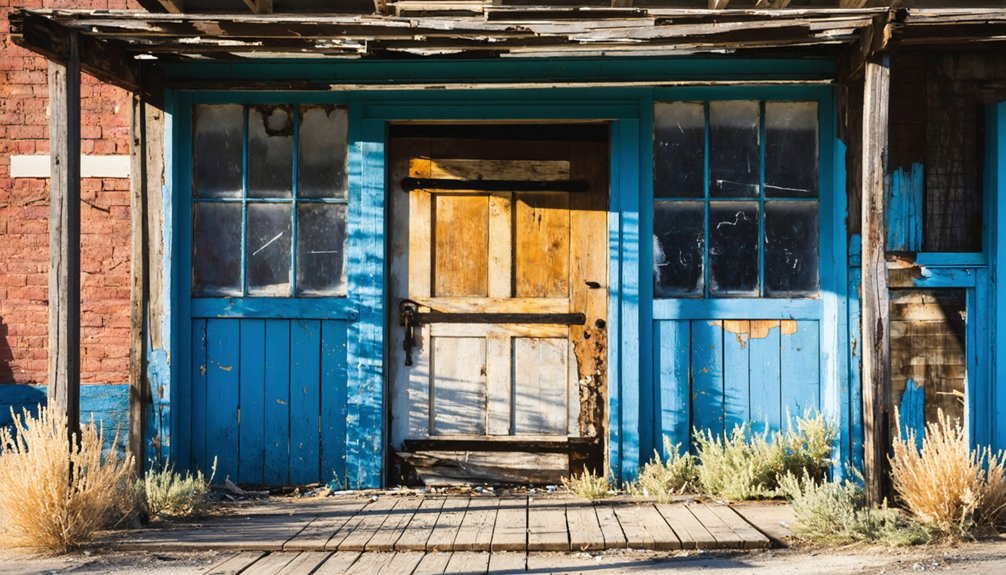You’ll find Boulder City nestled in northern Idaho’s Boundary County, a ghost town born from J.M. Schnatterly’s 1910 vision of a $3 million radium deposit. The settlement quickly grew to 60 buildings with 150 residents, including a schoolhouse and machine shop, all drawn by dreams of mineral wealth. While the promised riches never materialized, with only $150 in ore produced over 15 years, the site’s scattered foundations and 30-foot “Blue Hole” mine crater tell a fascinating tale of boom-and-bust ambition.
Key Takeaways
- Founded in 1910 by J.M. Schnatterly, Boulder City grew to 60 buildings after claims of a valuable radium deposit worth $3 million.
- Located in Boundary County, Idaho at 3,225 feet elevation, the ghost town is accessible via coordinates 48.6027183°N, -116.0693517°W.
- Despite early promises, mining operations yielded only $150 over 15 years, leading to the settlement’s eventual abandonment.
- Remnants include scattered foundations, weathered structures, a schoolhouse, and cemetery plots from its peak population of 150 residents.
- The “Blue Hole,” a 30-foot-deep mining crater, stands as the most prominent remaining feature of the failed mining venture.
The Birth of a Mining Settlement
When J.M. Schnatterly founded Boulder City in 1910, he’d a grand vision built on claims of a massive radium vein worth $3 million along Boulder Creek. His ambitious plan to create the world’s largest placer mine drew substantial investment, transforming a remote Idaho wilderness into a bustling frontier settlement.
Getting to Boulder City wasn’t easy – you’d have taken a train to Bonners Ferry, followed by a boat ride and horse-drawn buggy journey to reach the site. The project attracted $2 million capital from eager investors hoping to strike it rich. The treacherous journey required crossing creeks and climbing 2,300 feet elevation.
The arduous trek to Boulder City required train, boat, and buggy – a testament to frontier determination and isolation.
But as mining techniques evolved and infrastructure expanded, you’d have witnessed remarkable community growth. By the early 1920s, the settlement boasted around 60 buildings, including a schoolhouse and machine shop.
Steam-powered tramways, giant flumes, and high-pressure hoses reshaped the landscape as Schnatterly’s Idaho Gold and Ruby Mining Co. pursued its ambitious goals.
Dreams of Mineral Wealth
You’ll find Boulder City’s story riddled with outlandish claims, including J.M. Schnatterly’s reported discovery of a 15-inch radium vein that drew enthusiastic investors to the Idaho Gold and Radium Company.
While the settlement grew to 150 people and 60 buildings on the promise of mineral riches, the much-hyped “Blue Hole” never yielded the treasure trove investors desperately hoped to find.
Schnatterly provided free room and board to his workers during times of economic hardship, which helped prevent starvation among the mining families.
Modern analysis shows deposits containing 21.2% lead content were present at the site, suggesting some legitimate mineral potential existed despite the exaggerated claims.
The venture’s ultimate failure, marked by lawsuits and gunfights over mining claims, stands as a cautionary tale of how mining fever could transform dreams of wealth into costly disappointments.
Mining Dreams Gone Bust
Despite the promising geology of Boulder City‘s mountainsides, rich with deposits of silver, gold, copper, lead, and zinc, the mining settlement’s dreams of mineral wealth ultimately crumbled under the weight of reality.
While early mineral exploration yielded impressive ore grades – up to 58% lead and 92 ounces of silver per ton – the deposits proved frustratingly inconsistent for economic sustainability.
You’d have found the story of Boulder City’s decline written in cycles of boom and bust. After an initial $1 million ore boom in the 1890s, promoters like Schnatterly hyped discoveries and attracted investor capital with promises of untold riches.
The infamous “Blue Hole” venture epitomized this pattern – grand promises followed by disappointing yields. By the mid-1980s, the town’s total production reached just 110,000 ounces of silver, far below expectations. Today, only one structure remains from this once-bustling mining town, serving as a silent testament to its failed ambitions.
Gold Rush Investment Fever
Investment speculation reached a fever pitch as promoters revealed attractions like the “Blue Hole” to entice would-be millionaires.
Located 5.6 miles upstream from Highway 75, the town quickly expanded to 60 buildings, including a schoolhouse and machine shop, all funded by investors who pictured vast riches accumulating in mine shafts below the rugged Idaho terrain.
Similar to other mining settlements that emerged during the gold rush of 1862, Boulder City attracted thousands of eager prospectors seeking their fortunes in the mountainous region.
Radium’s False Promise
The allure of radium sparked Boulder City’s founding in 1910, when J.M. Schnatterly claimed he’d discovered a remarkable 15-inch wide radium vein along Boulder Creek.
You’d think such an extraordinary find would’ve attracted immediate verification, but the vein remained conveniently unseen by outsiders.
The radium hype proved to be Schnatterly’s masterstroke in attracting investor trust and capital.
He leveraged this unverified discovery to establish his Idaho Gold and Radium Company, later renamed Idaho Gold and Ruby Mining Company.
While he successfully secured funding to build infrastructure and a placer mining operation, the promised riches never materialized.
The operation raised approximately $2 million from investors before its ultimate failure.
Boulder City reached a peak population of 150 during its short-lived mining era.
Instead of radium wealth, investors faced betrayal as the operation yielded a mere $150 over 15 years, leading to multiple lawsuits and occasional gunfights over lost investments.
Life in the Mountain Camp
Living conditions in Boulder City’s mountain camp tested the resilience of its 150 peak residents during the 1920s mining boom.
Census records show the population fluctuated from 52 to 160 residents between 1900 and 1930.
You’d find a close-knit community housed in 35 identical cabins and bunkhouses along Boulder Creek Road, where miners and their families carved out a rugged existence in the mountainous terrain.
Community dynamics centered around shared spaces like the cookhouse, dining hall, and local store.
In this hardscrabble mountain camp, the cookhouse, dining hall and store became the heart of settlers’ daily interactions.
Your daily routines would’ve revolved around the mine’s demanding schedule, with support industries like blacksmithing and sawmilling keeping the camp operational.
While you’d send your children to the local school, you’d spend your days traversing the precarious Boulder Creek Road and dealing with limited amenities.
The hostile environment demanded grit, as you’d face the challenges of isolation and harsh mountain conditions together.
J.M. Schnatterly’s Vision and Legacy

Mining entrepreneur J.M. Schnatterly transformed Boulder Creek’s rugged terrain into a manifestation of audacious vision around 1910. His ambitions went far beyond typical mining ventures – he dreamed of creating the world’s largest placer mining operation in Idaho’s remote wilderness.
You’ll find Schnatterly’s legacy marked by three distinct achievements:
- Engineering a complex mining infrastructure in challenging terrain, including roads and a 60-building settlement.
- Raising roughly $2 million (about $50 million today) through masterful promotion and investor allure.
- Harnessing Boulder Creek’s natural features for an innovative placer mining system.
Though his claims of vast radium and gold deposits proved unfounded, Schnatterly’s promotional genius kept Boulder City alive for over a decade, attracting 150 residents at its peak and leaving behind a fascinating chapter in Idaho’s mining history.
The Rise and Fall of Mining Operations
While Boulder City’s mines yielded impressive early returns of over $1 million in gold and silver before 1900, you’ll find the later production figures fell short of investors’ grandiose expectations.
The area’s subsequent output of 110,000 ounces of silver, 610 ounces of gold, and 1.3 million pounds of lead between 1900 and the 1980s tells a story of diminishing returns despite ambitious promotional campaigns.
You’d discover that Schnatterly’s promises of vast radium and ruby deposits never materialized, leaving Boulder City’s mining operations to gradually fade into ghost town status by the mid-20th century.
Mining Production Statistics
Although Boulder City’s mines promised vast mineral wealth, production statistics reveal a stark contrast between expectations and reality.
Despite significant investments and the establishment of the Idaho Gold and Ruby Mining Company, mining yields consistently fell short of projections. You’ll find that while the area attracted up to 150 residents during the 1920s peak, production challenges ultimately led to the operation’s downfall.
- The mining camp supported 60 buildings and essential infrastructure, indicating substantial initial investment.
- Actual mineral extraction remained limited, with gold, ruby, and other mineral yields failing to meet investor expectations.
- Production struggles led to the eventual abandonment of operations, leaving behind little documentation of specific output figures.
The area’s mining legacy now exists primarily as a reflection of unrealized potential rather than successful mineral extraction.
False Promises, Empty Dreams
During the early 1900s, Boulder City’s ambitious mining venture began with bold promises that would ultimately prove hollow. Schnatterly stoked false optimism by announcing massive radium deposits and revealing plans for the world’s largest placer mining operation. You’d have thought Boulder Creek’s natural box canyon would deliver untold riches.
The reality proved devastating for investors caught up in the mining speculation frenzy. Despite grand promises and the ceremonial “Blue Hole” display, the operation yielded a mere $150 over 15 years.
The company repeatedly changed names, from Idaho Radium and Gold to Idaho Gold and Ruby Mining Company, while Schnatterly continued fleecing investors through aggressive fundraising tactics.
After his death in 1923, the operation’s facade crumbled completely, leaving Boulder City to fade into a ghost town by 1930.
Remnants of a Lost Community

Once bustling with nearly 60 buildings, Boulder City’s remnants now tell the story of a semi-permanent mining camp through its scattered foundations and weathered structures.
You’ll find traces of community dynamics in the schoolhouse ruins and cemetery plots, reflecting a population that fluctuated between mining booms and busts.
The historical significance of this lost community lives on through:
- A machine shop and service buildings that supported the Idaho Gold and Ruby Mining Co.’s operations
- The mysterious “Blue Hole,” a massive 30-foot-deep mining crater that stands as evidence of Schnatterly’s ambitious ventures
- Cemetery grounds that predate the town’s founding, offering glimpses into broader regional settlement patterns
Today, heavy snow and time have taken their toll, leaving only shadows of what was once a hopeful frontier settlement.
Finding Boulder City Today
If you’re planning to visit Boulder City’s historic site, you’ll find it nestled in northern Idaho’s Boundary County at an elevation of 3,225 feet, near the Canadian border.
Ghost town exploration here requires careful preparation, as there aren’t any maintained roads leading directly to the site. You’ll need to navigate using topographic maps or GPS coordinates (48.6027183°N, -116.0693517°W).
Plan ahead and pack wisely – this remote ghost town requires careful navigation through unmaintained terrain using GPS coordinates or topographic maps.
The closest modern settlements are Leonia, Yakt, and Moyie Springs, where you can gather supplies before venturing into the forested, mountainous terrain.
Historical preservation efforts haven’t established any formal tourist facilities or interpretive signage at the site. Weather conditions can limit access, particularly during winter months, so it’s best to plan your visit during favorable seasons.
The nearest amenities are available in Leonia.
Frequently Asked Questions
Are There Any Dangerous Animals or Hazards Visitors Should Watch For?
Watch for bears, mountain lions, and rattlesnakes during wildlife encounters, especially at dawn and dusk. You’ll need safety precautions like making noise and staying alert while exploring unstable structures.
What’s the Best Time of Year to Visit Boulder City?
Like many mountain destinations, you’ll want to plan your visit during late summer to early fall. That’s the best season with stable weather conditions, minimal snow, and manageable temperatures for the challenging hike.
Has Anyone Found Gold or Precious Minerals There Recently?
You won’t find any recent gold prospecting success stories here. There haven’t been verified mineral discoveries since the early 1900s claims. Today’s exploration and mining activities focus on other Idaho locations.
Are Metal Detectors Allowed at the Boulder City Site?
You shouldn’t use metal detectors here due to strict metal detecting regulations protecting historical artifacts. You’ll need special permits, and it’s likely prohibited since it’s a protected ghost town site.
Did Any Notable Crimes or Murders Occur in Boulder City?
Beyond Schnatterly’s gunfights and lawsuits, you won’t find documented murders or major crimes in Boulder City’s history. While ghost town legends persist, historical records don’t reveal significant criminal activity.
References
- http://www.fs.usda.gov/r01/idahopanhandle/recreation/idaho-gold-and-ruby-mine-boulder-city-ghost-town
- https://bonnersferryherald.com/news/2016/nov/24/a-history-of-boulder-city-continued-11/
- http://slightdetour.blogspot.com/2019/09/surprise-at-bouder-city.html
- https://miningconnection.com/surface/featured_stories/article/idahos_mining_ghost_town_is_destination_for_hardy_adventurers
- https://www.idahomagazine.com/article/the-life-and-times-of-boulder-basin/
- https://bonnersferryherald.com/news/2016/nov/17/boulder-city-shadows-of-a-mining-marvel-11/
- https://carrotranch.com/2015/10/24/cemetery-day-boulder-city-cemetery/
- https://www.idahogeology.org/pub/Staff_Reports/1997/S-97-3.pdf
- https://yellowpinetimes.wordpress.com/2022/12/18/idaho-history-dec-18-2022/
- https://history.idaho.gov/wp-content/uploads/2018/08/0009.pdf



